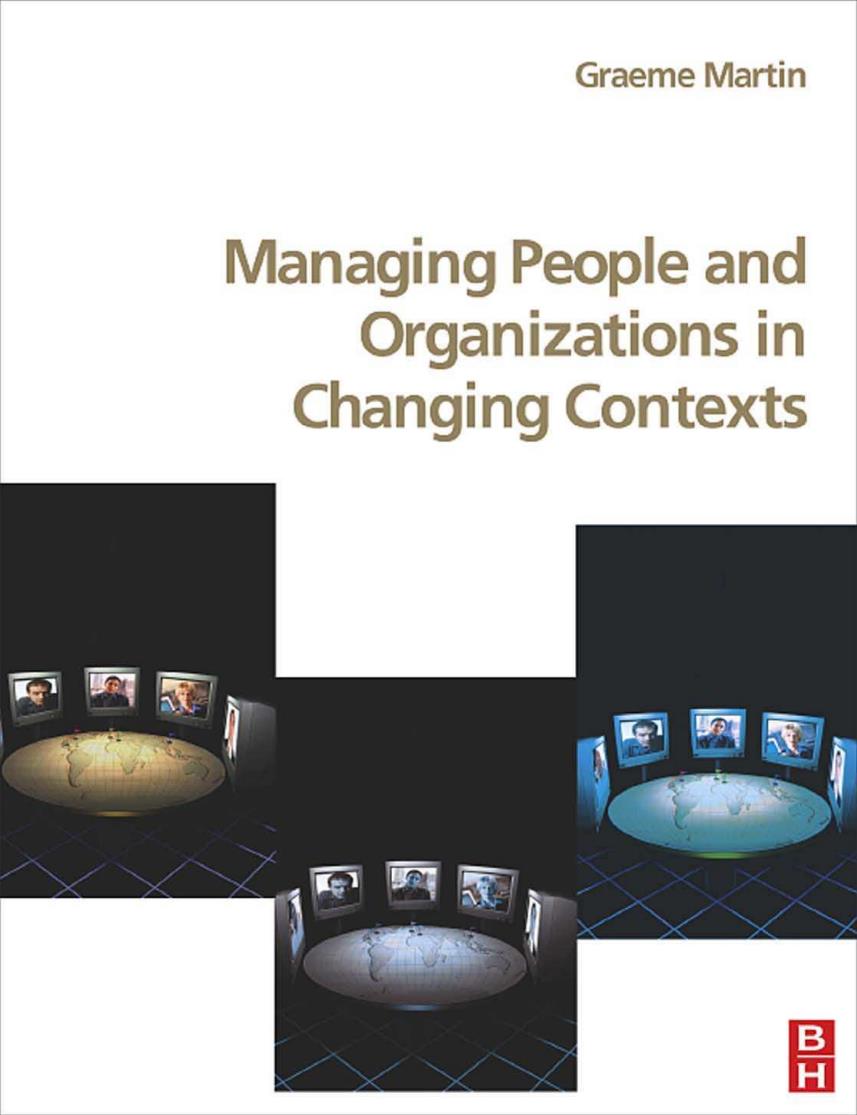
Graeme Martin Managing People and Organizations in Changing Contexts B
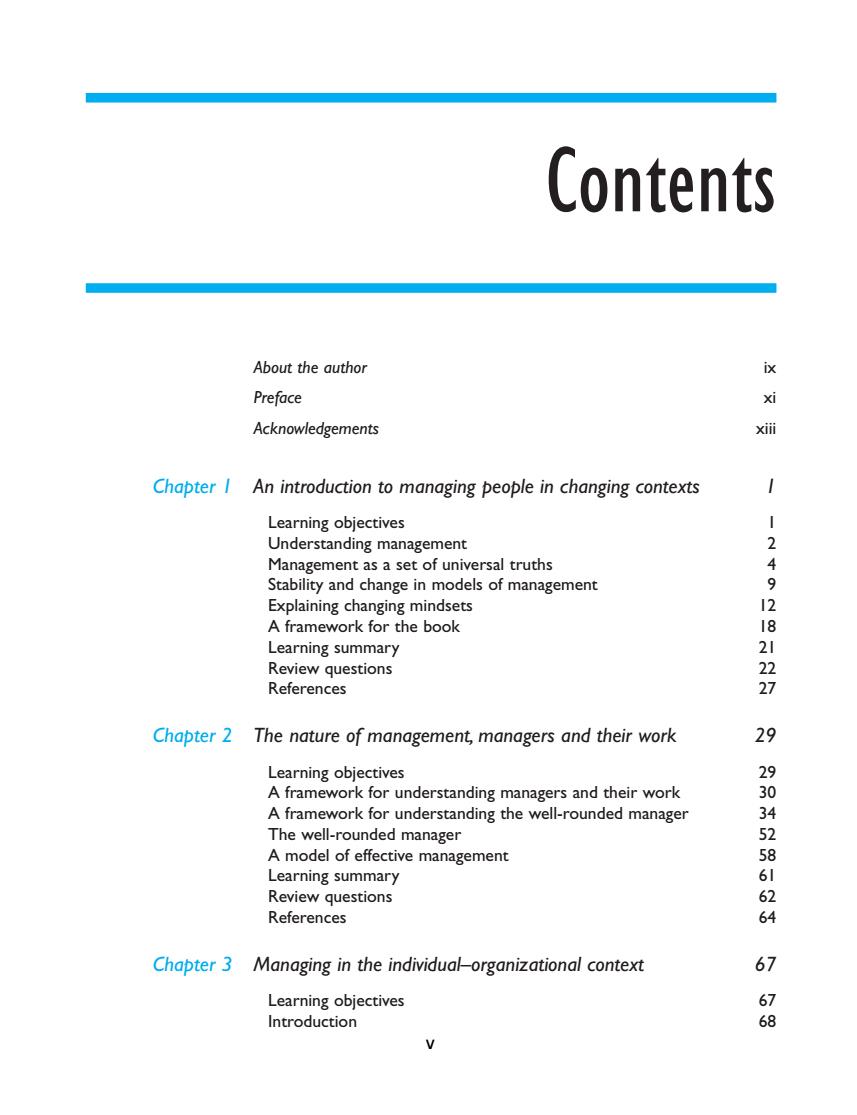
Contents About the author Preface Acknowledgements Chapter I An introduction to managing people in changing contexts Learning objectives Understanding management 2 Management as a set of universal truths Stability and change in models of management 9 the book Learning summary 21 Review questions References Chapter 2 The nature of management,managers and their work 9 Learning objectives 29 A framework for understanding managers and their work A framework for understanding the well-rounded manager 34 The well-rounded manager 52 A model of effective management Learning summary 86 Review questions 62 References Chapter 3 Managing in the individual-organizational context 67 Learning objectives 6 Introduction
Contents About the author ix Preface xi Acknowledgements xiii Chapter 1 An introduction to managing people in changing contexts 1 Learning objectives 1 Understanding management 2 Management as a set of universal truths 4 Stability and change in models of management 9 Explaining changing mindsets 12 A framework for the book 18 Learning summary 21 Review questions 22 References 27 Chapter 2 The nature of management, managers and their work 29 Learning objectives 29 A framework for understanding managers and their work 30 A framework for understanding the well-rounded manager 34 The well-rounded manager 52 A model of effective management 58 Learning summary 61 Review questions 62 References 64 Chapter 3 Managing in the individual–organizational context 67 Learning objectives 67 Introduction 68 v
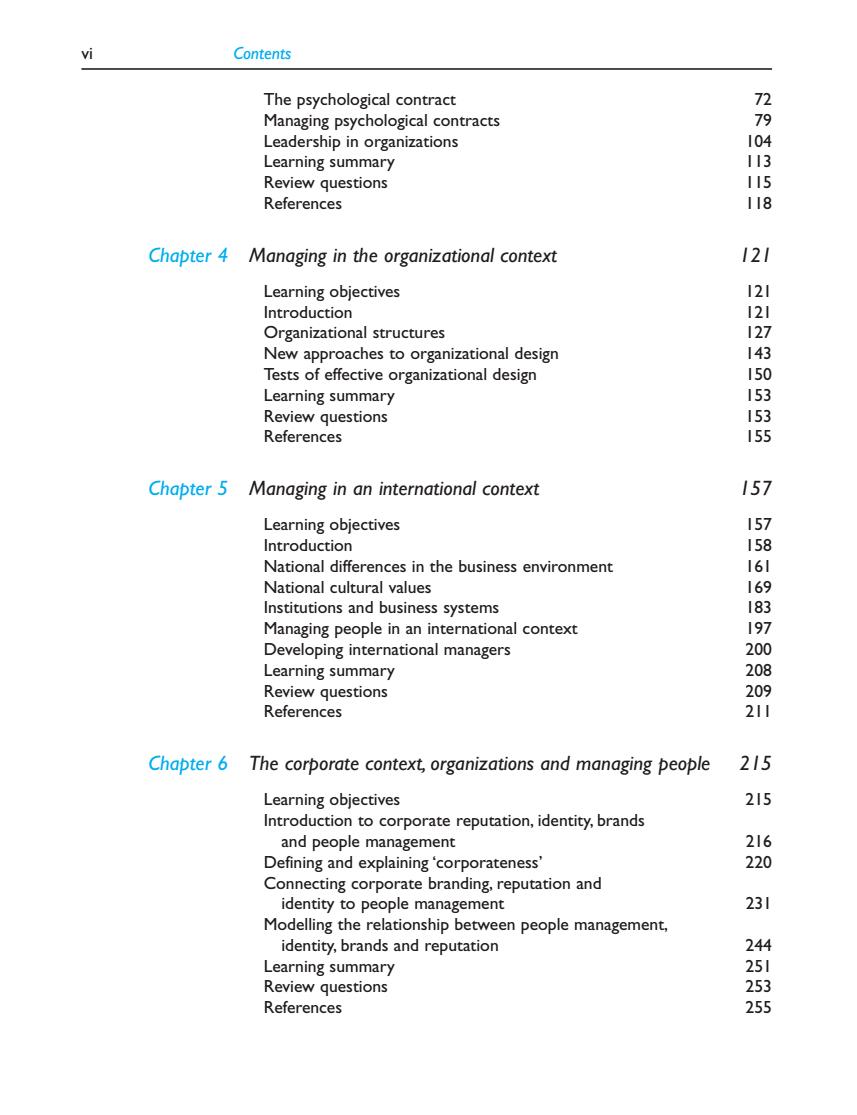
Contents Leadership in organizations Learning summary Review questions 115 References 118 Chapter 4 Managing in the organizational context 121 Learning objectives Introduction Organizational structures 22 New approaches to organizational design 43 Tests of effective organizational design 15 Learning summary Review questions References 5155 Chapter 5 Managing in an international context 157 Learning obiectives 157 the business National cultural values Institutions and business systems 69 Managing people in an international context 197 Developing international managers 200 Learning summary Review questions References 0 Chapter 6 The corporate context,organizations and managing people 215 Learning obiectives 215 Introduction to corporate reputation,identity,brands and people ma agement Defining and explaining'corporateness' 8 Connecting corporate branding,reputation and identity to people management 231 Modelling the relationship between people management identity,brands and reputation Learning summary Review questions 24412512 References 255
The psychological contract 72 Managing psychological contracts 79 Leadership in organizations 104 Learning summary 113 Review questions 115 References 118 Chapter 4 Managing in the organizational context 121 Learning objectives 121 Introduction 121 Organizational structures 127 New approaches to organizational design 143 Tests of effective organizational design 150 Learning summary 153 Review questions 153 References 155 Chapter 5 Managing in an international context 157 Learning objectives 157 Introduction 158 National differences in the business environment 161 National cultural values 169 Institutions and business systems 183 Managing people in an international context 197 Developing international managers 200 Learning summary 208 Review questions 209 References 211 Chapter 6 The corporate context, organizations and managing people 215 Learning objectives 215 Introduction to corporate reputation, identity, brands and people management 216 Defining and explaining ‘corporateness’ 220 Connecting corporate branding, reputation and identity to people management 231 Modelling the relationship between people management, identity, brands and reputation 244 Learning summary 251 Review questions 253 References 255 vi Contents
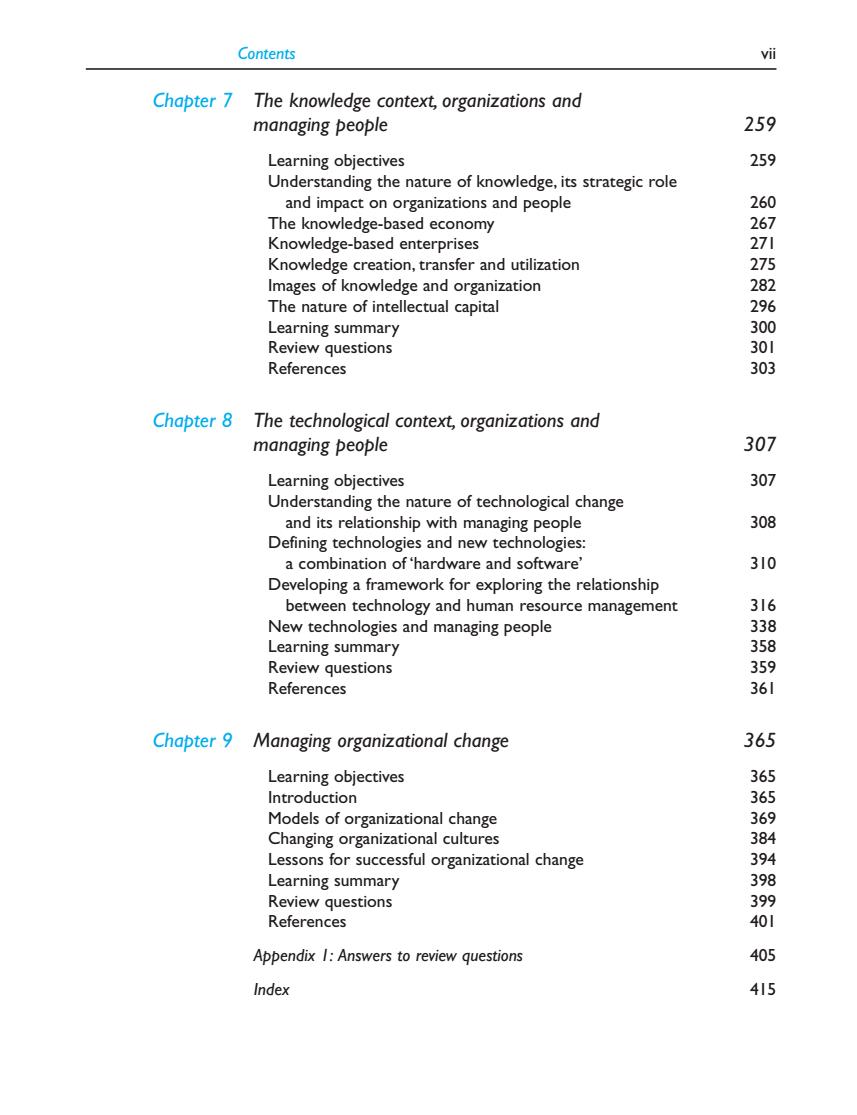
Contents Chapter 7 The knowledge context,organizations and managing people 259 Learning objectives 259 Understanding the nature of knowledge,its strategic role and impact on organizations and people 260 The knowledge-based economy 267 Knowledge-based enterprises 271 Knowledge creation,transfer and utilization 2 mages of knowled 8品 Learning summary 300 Review questions 301 References 303 Chapter 8 The technological context,organizations and managing people 307 Learning obiectives 307 Understanding the nature of technological change ship with 308 a combination of 'hardware and software 310 Developing a framework for exploring the relationship between technology and human resource management 316 d managing people Review questions References 361 Chapter 9 Managing organizational change 365 Learning objectives 365 oitoiorgntaiondldnre ction 365 Changing organizational cultures Lessons for successful organizational change 394 Learning summary 8 Appendix I:Answers to review questions 0s Index 415
Chapter 7 The knowledge context, organizations and managing people 259 Learning objectives 259 Understanding the nature of knowledge, its strategic role and impact on organizations and people 260 The knowledge-based economy 267 Knowledge-based enterprises 271 Knowledge creation, transfer and utilization 275 Images of knowledge and organization 282 The nature of intellectual capital 296 Learning summary 300 Review questions 301 References 303 Chapter 8 The technological context, organizations and managing people 307 Learning objectives 307 Understanding the nature of technological change and its relationship with managing people 308 Defining technologies and new technologies: a combination of ‘hardware and software’ 310 Developing a framework for exploring the relationship between technology and human resource management 316 New technologies and managing people 338 Learning summary 358 Review questions 359 References 361 Chapter 9 Managing organizational change 365 Learning objectives 365 Introduction 365 Models of organizational change 369 Changing organizational cultures 384 Lessons for successful organizational change 394 Learning summary 398 Review questions 399 References 401 Appendix 1: Answers to review questions 405 Index 415 Contents vii
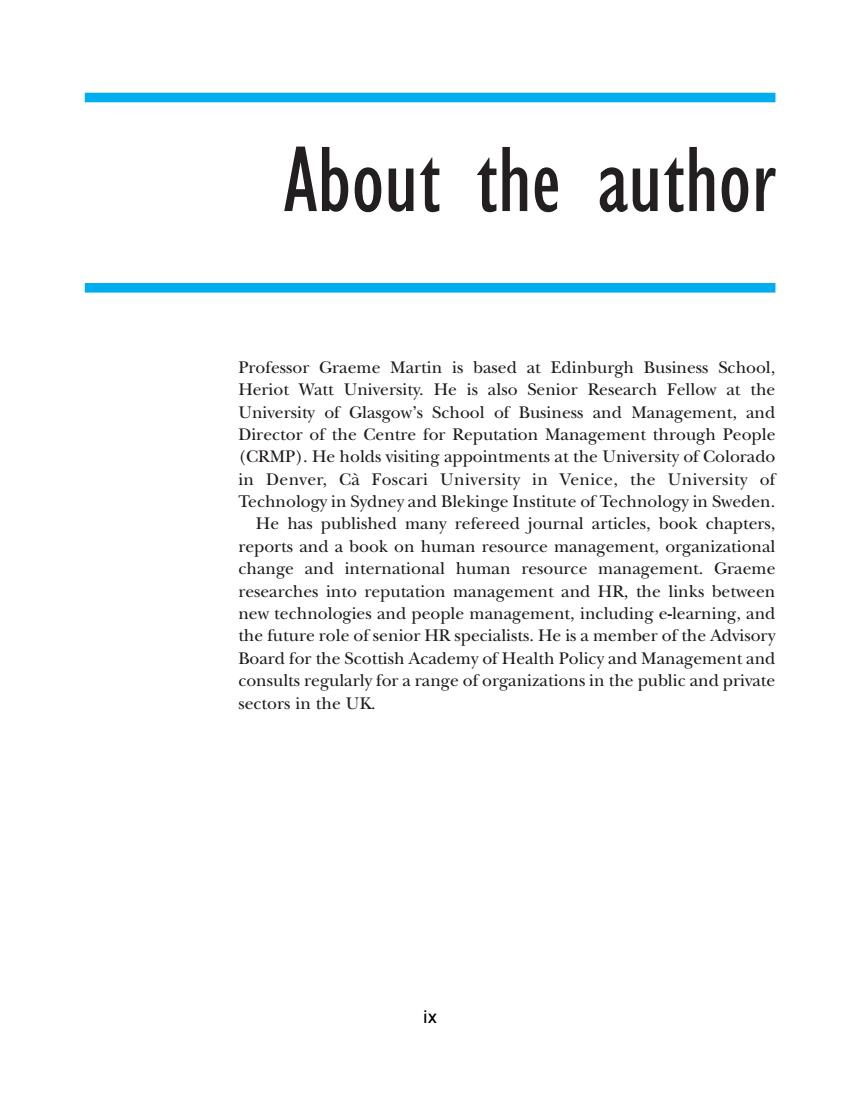
About the author Professor Graeme Martin is based at Edinburgh Business School, Heriot Watt University.He is also Senior Research Fellow at the University of Glasgow's School of Business and Management,and Director of the Centre for Reputation Management through People (CRMP).He holds visiting appointments at the University of Colorado in Denver,Ca Foscari University in Venice,the University of Technology in Sydney and Blekinge Institute of Technology in Sweden. He has published many refereed journal articles,book chapters reports and a book on human resource management,organizational change and international human resource management.Graeme researches into reputation management and HR,the links between new technologies and people management,including e-learning,and the future role ofsenior HR specialists.He is a member of the Advisory Board for the Scottish Academy of Health Policy and Management and consults regularly for a range of organizations in the public and private sectors in the UK. ix
About the author Professor Graeme Martin is based at Edinburgh Business School, Heriot Watt University. He is also Senior Research Fellow at the University of Glasgow’s School of Business and Management, and Director of the Centre for Reputation Management through People (CRMP). He holds visiting appointments at the University of Colorado in Denver, Cà Foscari University in Venice, the University of Technology in Sydney and Blekinge Institute of Technology in Sweden. He has published many refereed journal articles, book chapters, reports and a book on human resource management, organizational change and international human resource management. Graeme researches into reputation management and HR, the links between new technologies and people management, including e-learning, and the future role of senior HR specialists. He is a member of the Advisory Board for the Scottish Academy of Health Policy and Management and consults regularly for a range of organizations in the public and private sectors in the UK. ix